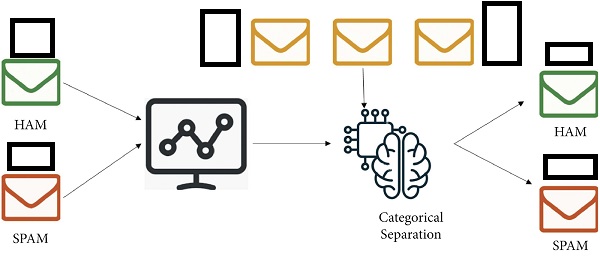Filter the content and identify spam using ai
In today’s digital landscape, the volume of online content continues to surge, making it increasingly challenging to maintain quality and authenticity. Fortunately, advancements in artificial intelligence (AI) have paved the way for innovative solutions to filter and identify spam using ai effectively. In this article, we’ll explore how AI technologies can revolutionize content moderation, ensuring a cleaner and more trustworthy online environment.
Understanding the Challenge of Spam Content:
Spam content encompasses a wide range of undesirable material, including fake news, malicious links, irrelevant advertisements, and low-quality or plagiarized articles. Left unchecked, spam can undermine the credibility of online platforms, erode user trust, and diminish the overall user experience.
The Role of AI in Content Moderation:
AI algorithms have emerged as powerful tools for content moderation, capable of analyzing vast amounts of data with speed and accuracy. By leveraging machine learning techniques, AI models can learn to distinguish between legitimate content and spam, thereby automating the process of content filtering and identification.
Key Strategies for Filtering and Identifying Spam Using AI:
1. Natural Language Processing (NLP): NLP algorithms analyze the textual content of articles, comments, and messages to identify patterns indicative of spam. By detecting grammar errors, unusual language patterns, and repetitive phrases, NLP models can flag suspicious content for further review.
2. Sentiment Analysis: Sentiment analysis algorithms assess the tone and sentiment of text to determine whether it aligns with the intended purpose of the platform. Content exhibiting overly promotional language, aggressive tones, or inflammatory rhetoric may be flagged as spam based on sentiment analysis.
3. Link Analysis: AI-powered link analysis examines the URLs embedded within content to assess their credibility and relevance. Links leading to known spam domains, phishing websites, or malicious content can be automatically identified and filtered out to prevent users from accessing harmful material.
4. Image Recognition: Image recognition algorithms scan visual content for signs of spam, such as watermarks indicating stock imagery, low-quality graphics, or inappropriate content. By analyzing image attributes and metadata, AI models can identify and flag spammy images effectively.
5. User Behavior Analysis: AI systems can analyze user behavior data, such as engagement patterns, click-through rates, and interaction histories, to identify suspicious activity indicative of spam accounts or bot-driven behavior. Unusual spikes in activity or anomalous behavior can trigger further investigation by moderators.
Benefits of AI-Powered Spam Detection:
Efficiency: AI algorithms can process and analyze content at scale, enabling platforms to handle large volumes of user-generated content effectively.
Accuracy: AI models continuously learn and adapt to evolving spam tactics, improving their accuracy and effectiveness over time.
Scalability: AI-powered solutions can be easily scaled to accommodate growing user bases and increasing volumes of content, ensuring consistent and reliable spam detection.
AI-driven technologies hold immense promise for filtering and identifying spam content, safeguarding online platforms against malicious actors and preserving the integrity of digital ecosystems. By harnessing the power of AI algorithms for content moderation, organizations can foster a safer, more trustworthy online environment for users worldwide.
In an era inundated with digital content, maintaining quality and authenticity is paramount for online platforms. However, the proliferation of spam poses a significant challenge to content moderation efforts. Leveraging the capabilities of artificial intelligence (AI), organizations can implement advanced techniques to filter content effectively and identify spam. This article explores the innovative AI-driven strategies that revolutionize content moderation, ensuring a cleaner and safer online experience for users.
Understanding the Spam Epidemic:
Spam, in its various forms, inundates online platforms, diminishing user experience and tarnishing the reputation of digital ecosystems. From fraudulent advertisements to malicious links and low-quality content, spam undermines the integrity of online communities and erodes user trust.
The Role of AI in Content Moderation:
AI emerges as a formidable ally in the battle against spam, offering sophisticated algorithms capable of analyzing vast amounts of data with precision and efficiency. By harnessing the power of machine learning and natural language processing (NLP), AI-driven systems can discern between genuine content and spam, empowering platforms to maintain quality standards and foster a conducive online environment.
Advanced AI Strategies for Content Filtering and Spam Detection:
1. Natural Language Processing (NLP): NLP algorithms dissect textual content, identifying linguistic anomalies, grammar errors, and patterns indicative of spam. By analyzing language semantics and syntax, NLP models flag suspicious content for further scrutiny, mitigating the dissemination of spammy material.
2. Sentiment Analysis: Sentiment analysis algorithms evaluate the emotional tone and intent behind textual content, distinguishing between genuine discourse and potentially harmful messages. Content exhibiting negative sentiment, aggression, or deceitful tactics is promptly identified as spam, safeguarding users from deceptive practices.
3. Link Analysis: AI-powered link analysis scrutinizes embedded URLs, assessing their credibility and relevance to the context. By detecting malicious links, phishing attempts, and dubious domains, AI models prevent users from accessing harmful content and safeguard digital assets against cyber threats.
4. Image Recognition: Image recognition algorithms analyze visual content, identifying characteristics associated with spam, such as low-quality graphics, inappropriate imagery, or watermarks indicative of stock photos. Through image analysis, AI systems enhance content filtering capabilities, ensuring the integrity of multimedia content.
5. Behavioral Analysis: AI systems monitor user behavior patterns, detecting anomalies and aberrations indicative of spam accounts or automated bot activity. By analyzing engagement metrics, click-through rates, and interaction patterns, AI models identify suspicious behavior and mitigate spam propagation effectively.

Benefits of AI-Powered Content Moderation:
Efficiency: AI-driven systems automate content moderation processes, enabling platforms to handle large volumes of data with speed and accuracy.
Accuracy: AI algorithms continuously learn from data patterns, enhancing their ability to detect and filter spam with precision and reliability.
Scalability: AI-powered solutions are inherently scalable, adapting to evolving content trends and user behavior patterns without compromising performance.
AI-powered content filtering and spam detection represent a paradigm shift in digital moderation practices, offering unprecedented capabilities to combat spam and maintain content quality. By harnessing the capabilities of AI algorithms, organizations can fortify their online platforms against spam attacks, ensuring a secure and trustworthy environment for users worldwide.
In the dynamic realm of cyberspace, ensuring the integrity of digital content is essential for fostering a safe and engaging online environment. However, the pervasive threat of spam poses a significant challenge, undermining user experience and eroding trust. Fortunately, advancements in artificial intelligence (AI) have heralded a new era of content moderation, enabling platforms to deploy sophisticated techniques for filtering and identifying spam. This article explores how AI technologies are revolutionizing content moderation, empowering organizations to combat spam effectively and uphold the quality of digital spaces.
Understanding the Menace of Spam:
Spam manifests in various forms, from unsolicited advertisements and deceptive promotions to fraudulent schemes and malicious content. Its proliferation not only inundates online platforms but also jeopardizes user safety, privacy, and trust. Tackling this menace requires proactive measures to filter out spam and preserve the integrity of digital ecosystems.
The Role of AI in Content Moderation:
AI emerges as a potent ally in the battle against spam, offering advanced algorithms capable of analyzing vast volumes of data with speed and precision. By leveraging machine learning, natural language processing (NLP), and other AI techniques, organizations can automate content moderation processes and identify spam more effectively than ever before.
Cutting-Edge AI Strategies for Content Filtering and Spam Detection:
1. Natural Language Processing (NLP): NLP algorithms scrutinize textual content, parsing language patterns, and semantics to identify spam signals such as grammar errors, repetitive phrases, and deceptive language. By analyzing linguistic nuances, NLP models can flag suspicious content for further review, mitigating the spread of spam.
2. Sentiment Analysis: Sentiment analysis algorithms evaluate the emotional tone and intent conveyed in text, distinguishing between genuine discourse and potentially harmful content. By detecting negative sentiment, aggression, or fraudulent claims, sentiment analysis helps identify spam and protect users from deceptive practices.
3. Link Analysis: AI-powered link analysis examines URLs embedded in content, assessing their credibility and relevance. By detecting malicious links, phishing attempts, and suspicious domains, AI models prevent users from accessing harmful content and mitigate the spread of spam-related threats.
4. Image Recognition: Image recognition algorithms analyze visual content, identifying characteristics indicative of spam such as low-quality graphics, inappropriate imagery, or watermarks from stock photo libraries. By scanning images for spam signals, AI systems enhance content filtering capabilities and maintain the integrity of multimedia content.
5. Behavioral Analysis: AI systems analyze user behavior patterns, detecting anomalies and deviations indicative of spam accounts or automated bot activity. By monitoring engagement metrics, click-through rates, and interaction patterns, AI models identify suspicious behavior and mitigate spam propagation effectively.
Benefits of AI-Driven Content Moderation:
Efficiency: AI-powered systems streamline content moderation processes, enabling platforms to handle large volumes of data with speed and accuracy.
Accuracy: AI algorithms continuously learn from data patterns, enhancing their ability to detect and filter spam with precision and reliability.
Scalability: AI-driven solutions are scalable, adapting to evolving content trends and user behavior patterns without compromising performance.
AI-powered content filtering represents a pivotal advancement in combating spam and preserving the quality of digital spaces. By harnessing the capabilities of AI algorithms, organizations can fortify their online platforms against spam attacks, fostering a safer and more trustworthy online environment for users worldwide.
In the vast expanse of the digital world, maintaining the integrity of online content is paramount. However, the persistent threat of spam poses a significant challenge, hindering user experience and undermining trust. Leveraging the power of artificial intelligence (AI), organizations can now deploy advanced techniques to filter out spam effectively and elevate the quality of digital content. This article delves into the transformative impact of AI in content moderation, shedding light on innovative strategies to combat spam and safeguard online environments.
Understanding the Gravity of Spam:
Spam infiltrates digital platforms in various forms, including unsolicited advertisements, fraudulent schemes, and misleading content. Beyond cluttering digital spaces, spam jeopardizes user engagement, privacy, and overall satisfaction. Addressing this issue demands proactive measures to filter out spam and uphold the credibility of online ecosystems.
The Evolution of AI in Content Moderation:
AI emerges as a game-changer in the fight against spam, offering unparalleled capabilities to analyze vast datasets and detect patterns with precision. By harnessing machine learning, natural language processing (NLP), and other AI technologies, organizations can automate content moderation tasks and identify spam with remarkable accuracy.
Cutting-edge AI Strategies for Content Filtering and Spam Detection:
1. Natural Language Processing (NLP): NLP algorithms scrutinize textual content, identifying linguistic anomalies, grammar errors, and repetitive patterns indicative of spam. By parsing language semantics, NLP models can flag suspicious content and prevent its dissemination across digital platforms.
2. Sentiment Analysis: Sentiment analysis algorithms assess the emotional tone and intent conveyed in text, distinguishing between genuine communication and spammy content. By detecting negative sentiment, aggressive language, or fraudulent claims, sentiment analysis aids in identifying and filtering out spam effectively.
3. Link Analysis: AI-powered link analysis examines URLs embedded in content, evaluating their credibility and relevance. By detecting malicious links, phishing attempts, and suspicious domains, AI models mitigate the spread of spam-related threats and protect users from potential harm.
4. Image Recognition: Image recognition algorithms analyze visual content, detecting signs of spam such as low-quality graphics, inappropriate imagery, or watermarks from stock photo libraries. By scanning images for spam signals, AI systems bolster content filtering mechanisms and maintain the authenticity of multimedia content.
5. Behavioral Analysis: AI-driven behavioral analysis monitors user interactions and engagement patterns, identifying anomalies indicative of spam accounts or automated bot activity. By analyzing click-through rates, interaction frequencies, and other behavioral metrics, AI models mitigate spam propagation and preserve digital integrity.
Benefits of AI-Driven Content Moderation:
Efficiency: AI-powered systems streamline content moderation processes, enabling platforms to handle large volumes of data efficiently.
Accuracy: AI algorithms continuously learn from data patterns, enhancing their ability to detect and filter spam with precision.
Scalability: AI-driven solutions are adaptable to evolving content trends and user behavior patterns, ensuring consistent performance and effectiveness.
AI-powered content moderation represents a paradigm shift in combating spam and enhancing digital content quality. By leveraging AI technologies, organizations can fortify their online platforms against spam attacks, fostering a safer, more trustworthy digital environment for users worldwide.





